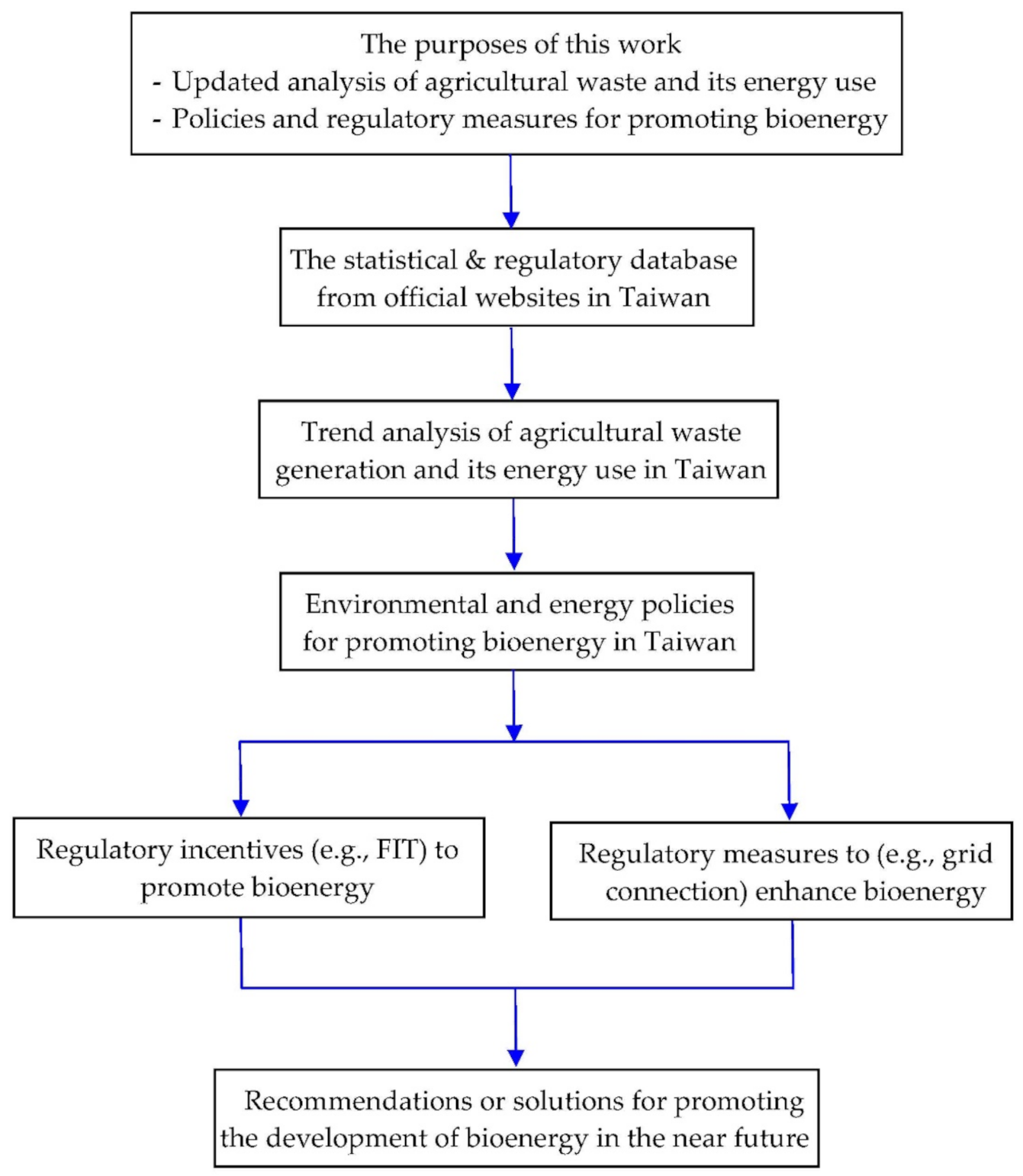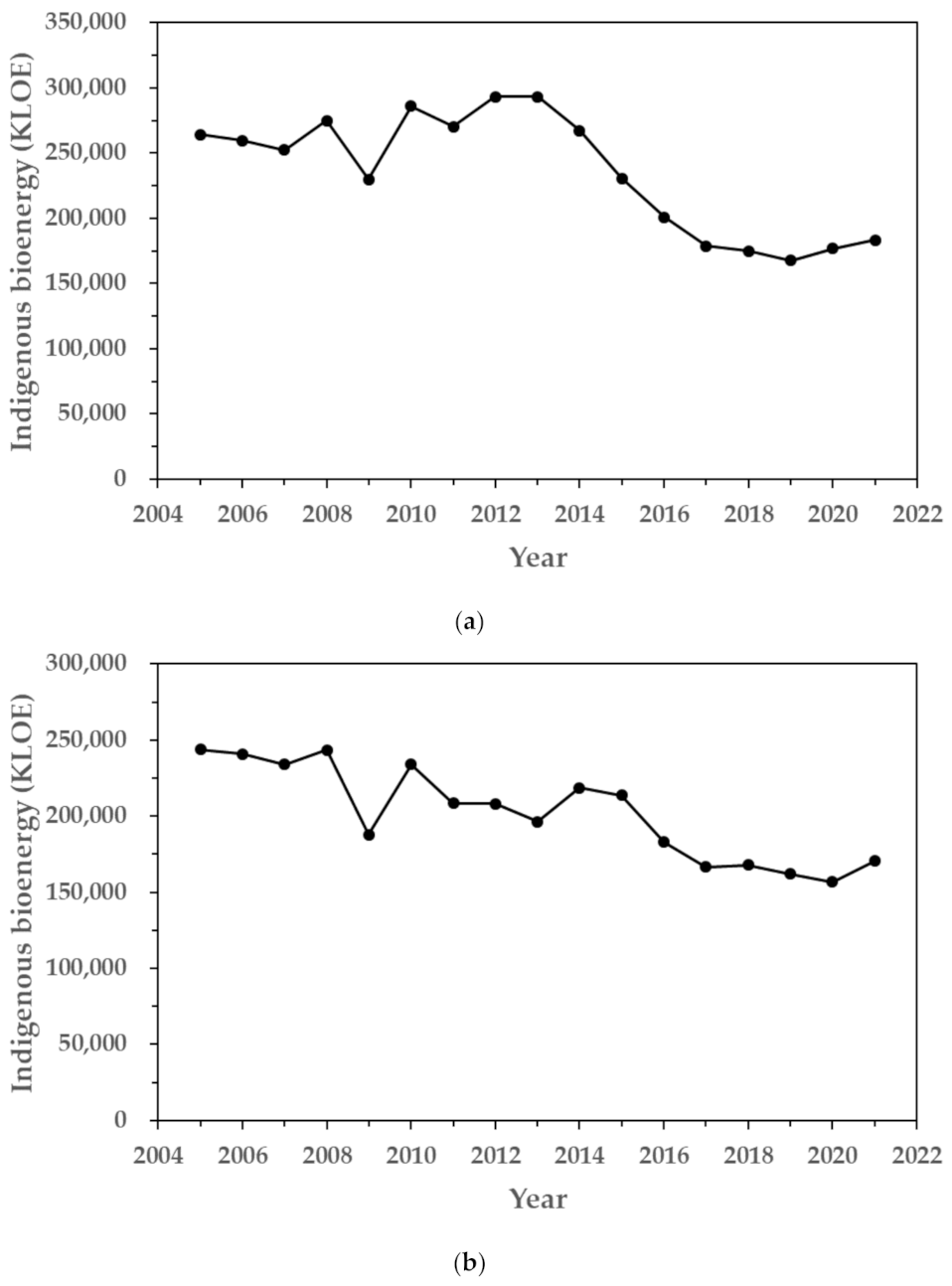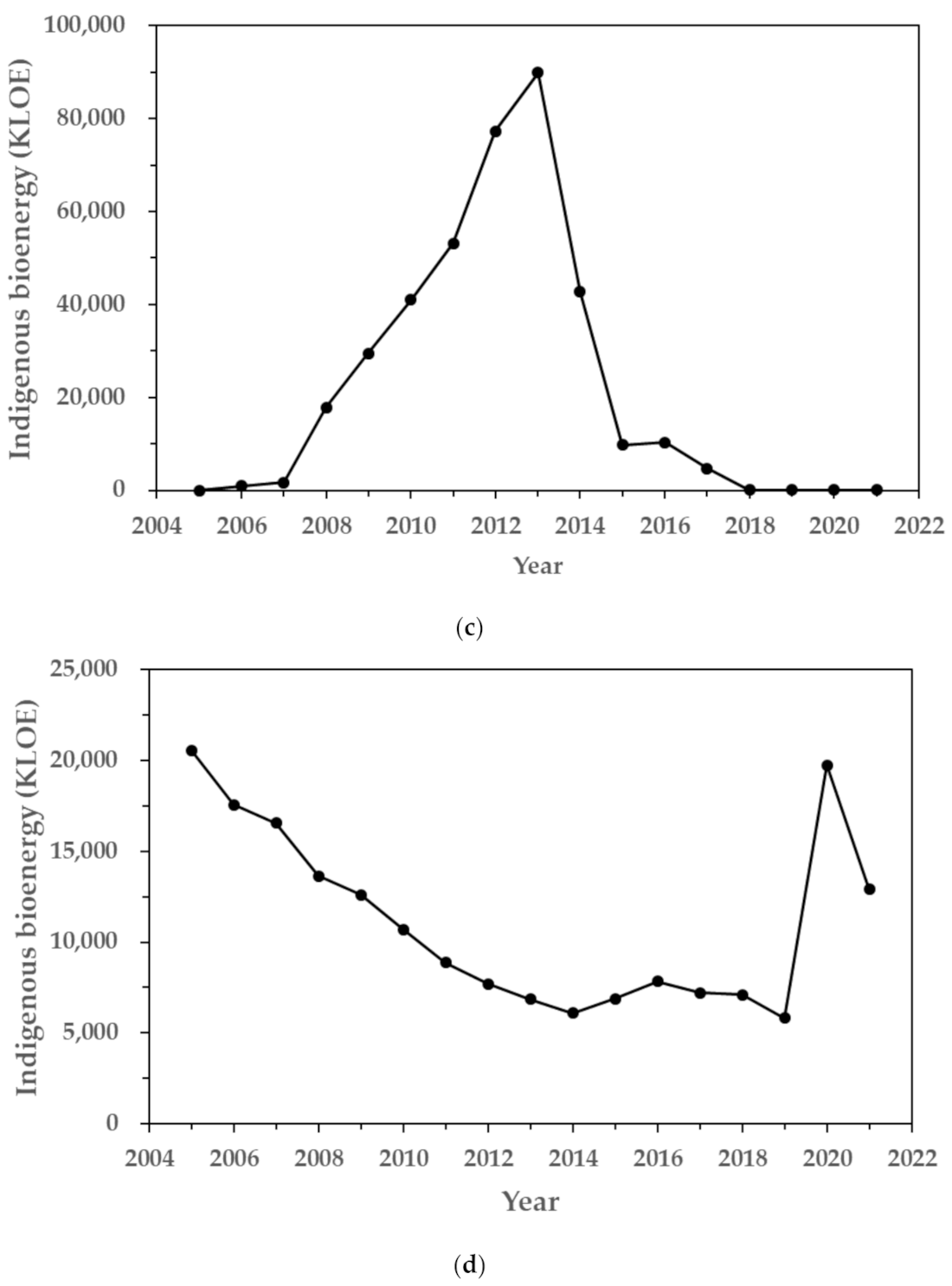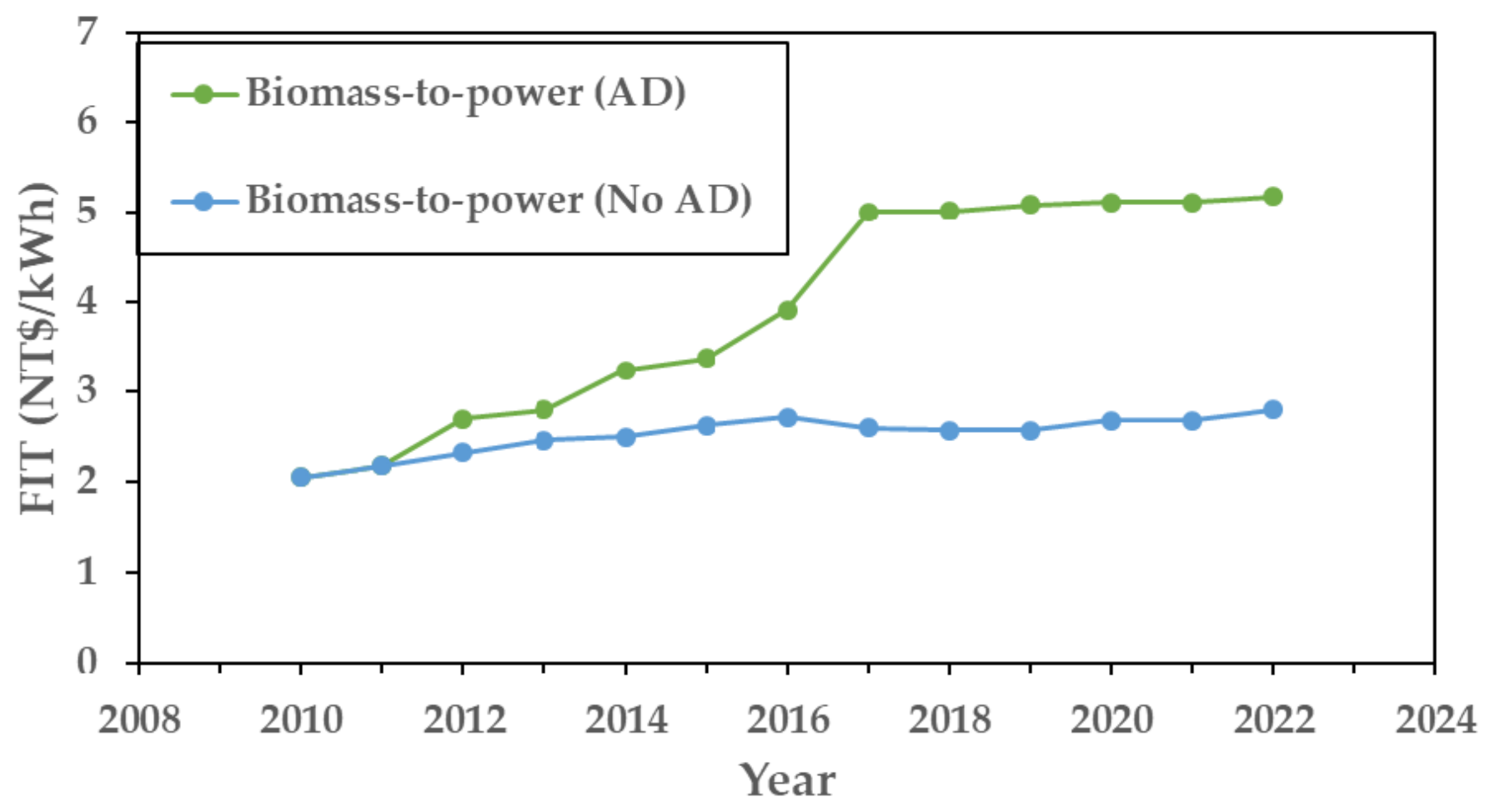Overview of Biomass-to-Energy Supply and Promotion Policy in Taiwan
Abstract
1. Introduction
2. Data Mining
- Baseline data of the generated amounts of agricultural waste and its energy use
- Environmental and energy policies for promoting biomass-to-energy
- Regulatory measures and incentives for promoting biomass-to-energy
3. Status of Biomass-to-Energy in Taiwan
3.1. Status of Agricultural Waste Generation
- -
- In brief, the agricultural waste generation in Taiwan ranged from 4.5 to 5.2 million metric tons. About 80% of that was from rice-derived residues (rice straw and rice husk) and livestock/poultry-derived waste (manure mainly produced from swine- and cattle-raising). Other significant agriculture-derived residues included spent mushroom compost, oyster shell, and fruit/vegetable residues.
- -
- In order to expand the supply of indigenous biological waste, thinned fruit twigs and bamboo residue were grouped into the statistical items of agriculture-derived waste since 2020. As listed in Table 1, the amounts of thinned fruit twigs accounted for about 250 thousand metric tons, which were derived from a variety of subtropical/tropical fruits like banana, pineapple, citrus, longan, mango, guava, grape, and lichee [9]. In addition, bamboo residues may include bamboo branches, leaves, shoot apex, joint, skin, sawdust, and shoot shell [14]. According to the Forestry Statistics Yearbook [10], the area of bamboo forest amounted to about 191.6 thousand hectares, representing Taiwan’s rich bamboo resources.
- -
- Regarding the fishery-derived waste, it should include various scraps (e.g., head, tail, shell, internal organs, scale, leather, fin, and bone) after processing or eating fishes, shellfishes, and other aquaculture animals. In Taiwan, the COA only provided the statistics of oyster shell in the fishery-derived waste, indicating a declining trend from 226 thousand metric tons in 2005 to 99 thousand metric tons in 2021. Because of its chemical composition (i.e., CaCO3), this biological waste is not relevant to energy use.
3.2. Status of Biomass-to-Energy
- -
- As seen in Figure 2a, although the energy supply from indigenous biomass or bioenergy indicated a slight increase since 2019, the reduction from the highest value (293,275 KLOE) in 2013 has exceeded 37.4% in comparison with the value in 2021 (i.e., 183,508 KLOE). Obviously, indigenous bioenergy was mostly from indigenous solid biomass resources (Figure 2b), including waste wood and sugarcane bagasse. These solid-type biofuels were generally reused as auxiliary fuels in industrial boilers and heaters.
- -
- As listed in Table 2, the imported energy from biomass has been supplied since the late 2010s, which mainly referred to the imported palm kernel shell for stream generation in the industrial use [16]. Because of the high price of palm kernel shell imported from Southeastern Asian countries in recent years, the imported energy supply has significantly decreased from about 9000 KLOE in 2018 (the highest) to close to zero in 2021.
- -
- In Taiwan, waste cooking oil (WCO) has been reused as a feedstock for biodiesel production since 2006. Under the policy promotion, the supply amounts of biodiesel indicated a soaring growth from 1029 kiloliters in 2006 to 96,373 kiloliters in 2013 [7]. However, the users have complained about some issues, including fuel tank and filter clogging/plugging, ignition delay, and exhaust emissions at higher levels. The Taiwanese government thus temporarily terminated the biodiesel blends (B2) promotion policy in May 2014. Since then, the B2 supply and consumption showed a rapid decline, as shown in Figure 2c. In order to continuously support WCO recycling in Taiwan, the vast majority of biodiesel by domestic production was exported to European (e.g., Spain) and Asian countries (e.g., South Korea).
- -
- The policy for promoting the use of bioethanol and its domestic production plan started from 2007 [17]. Since then, limited gas stations in the metropolitan cities (i.e., 8 gas stations in Taiwan city and 6 gas stations in Kaohsiung city) provided E3 gasohol for all vehicles by subsidizing a discount rate at NT $1.0–2.0 per liter. However, the bioethanol in the E3 gasohol was completely imported because the commercial establishment of a new bioethanol plant in Taiwan was not profitable from the feasibility study. As listed in Table 2, the supply amounts of bioethanol indicated a decreasing trend, which could be attributed to the inconvenient refueling and insufficient incentives [17]. In the future, the bioethanol must be domestically produced from non-food lignocellulosic resources like crop residues (e.g., rice straw), kitchen waste (food waste), and wood chips.
- -
- The variation in energy supply from indigenous gas-type bioenergy indicated a fluctuating pattern (Figure 2d). During the period of 2005–2014, it can be seen that the energy supply from biogas-to-power decreased mainly as a result of the depletion of landfill gas from sanitary landfill plants in Taiwan. However, the EPA and COA have jointly managed the applications of livestock (pig and cattle) farms for producing digestate and biogas-to-power from the anaerobic digestion (AD) process since 2015. Since then, it showed an upward trend in bioenergy by biogas-to-power.
4. Policies for Promoting Biomass-to-Energy in Taiwan
4.1. Ministry of Economic Affairs (MOEA)
4.2. Council of Agriculture (COA)
4.3. Environmental Protection Administration (EPA)
5. Regulatory Incentives and Measures for Biomass-to-Energy in Taiwan
6. Conclusions and Recommendations
- -
- Expanding the indigenous bioenergy sources, including bamboo residues, spent mushroom compost, biological sludge, thinned fruit twigs, and cattle manure.
- -
- Deregulating the restriction on the establishment of biomass-to-power plants in industrial parks. Furthermore, agricultural lands, especially in livestock/poultry farms, can be permitted to establish biogas-to-power systems.
- -
- Promoting the use of biomass-based solid recovered fuel (SRF) in industrial boilers and heaters. In addition, co-firing with the addition of biomass as a partial substitute fuel in high-efficiency coal-fired power plants may be performed to mitigate the emissions of GHGs.
- -
- Increasing the FIT rates of biomass-to-power because of the increased capital and operating costs in recent years.
- -
- Promulgating the specific agricultural waste (rice-derived residues) management regulations to conduct a sustainable material management priority through recycling and biomass-to-energy technologies like gasification.
Author Contributions
Funding
Institutional Review Board Statement
Informed Consent Statement
Data Availability Statement
Conflicts of Interest
References
- Bioenergy. International Energy Agency, IEA. Available online: https://www.iea.org/fuels-and-technologies/bioenergy (accessed on 2 August 2022).
- Basu, P. Biomass Gasification, Pyrolysis and Torrefaction, 2nd ed.; Academic Press: London, UK, 2013; pp. 47–86. [Google Scholar]
- De Jong, W. Physical pretreatment of biomass. In Biomass as a Sustainable Energy Source for the Future: Fundamentals of Conversion Processes; de Jong, W., van Ommen, J.R., Eds.; John Wiley & Sons: Hoboken, NJ, USA, 2015; pp. 233–267. [Google Scholar]
- Ministry of Economic Affairs (MOEA, Taiwan). Energy Statistics Handbook-2021; MOEA: Taipei, Taiwan, 2022.
- Environmental Protection Administration (EPA). Taiwan Greenhouse Gases Inventory; EPA: Taipei, Taiwan, 2021.
- Guidelines on Energy Development. Bureau of Energy, Ministry of Economic Affairs, Taiwan. Available online: https://www.moeaboe.gov.tw/ECW/english/content/ContentDesc.aspx?menu_id=2042 (accessed on 2 August 2022).
- Energy Statistics. Bureau of Energy, Ministry of Economic Affairs, Taiwan. Available online: https://www.moeaboe.gov.tw/ECW/english/content/SubMenu.aspx?menu_id=8706 (accessed on 2 August 2022).
- Green National Income Account—Agricultural Solid Waste. Council of Agriculture, Taiwan. Available online: https://agrstat.coa.gov.tw/sdweb/public/common/Download.aspx (accessed on 16 August 2022).
- Agriculture Statistics Yearbook. Council of Agriculture, Taiwan. Available online: https://agrstat.coa.gov.tw/sdweb/public/book/Book.aspx (accessed on 16 August 2022).
- Forestry Statistics Yearbook. Forestry Bureau, Council of Agriculture, Taiwan. Available online: https://www.forest.gov.tw/0000110 (accessed on 16 August 2022).
- Multiple Waste Treatment Plan. Environmental Protection Administration, Taiwan. Available online: https://www.ey.gov.tw/Page/448DE008087A1971/8f06d8fb-0864-41b3-911e-a8e31ed16b60 (accessed on 25 July 2022). (In Chinese)
- Energy Transition White Paper. Ministry of Economic Affairs, Taiwan. Available online: https://www.moeaboe.gov.tw/ECW/populace/content/ContentLink2.aspx?menu_id=48 (accessed on 25 July 2022). (In Chinese)
- Renewable Energy Development Act. Ministry of Economic Affairs, Taiwan. Available online: https://law.moj.gov.tw/ENG/LawClass/LawAll.aspx?pcode=J0130032 (accessed on 25 July 2022).
- Gu, X.; Deng, X.; Liu, Y.; Zeng, Q.; Wu, X.; Ni, Y.; Liu, X.; Wu, T.; Fang, P.; Wang, B.; et al. Review on comprehensive utilization of bamboo residues. Trans. Chin. Soc. Agri. Eng. 2016, 32, 236–242. [Google Scholar]
- Tsai, W.T.; Hsien, K.J. An analysis of cogeneration system utilized as sustainable energy in the industrial sector in Taiwan. Renew. Sustain. Energy Rev. 2007, 11, 2104–2120. [Google Scholar] [CrossRef]
- Tsai, W.T. Benefit analysis and regulatory actions for imported palm kernel shell as an environment-friendly energy source in Taiwan. Resources 2019, 8, 8. [Google Scholar] [CrossRef]
- Lee, Y.R.; Tsai, W.T. Bottlenecks in the development of bioethanol from lignocellulosic resources for the circular economy in Taiwan. Fermentation 2021, 7, 131. [Google Scholar] [CrossRef]
- Lee, Y.R.; Tsai, W.T. Valorization of value-added resources from the anaerobic digestion of swine-raising manure for circular economy in Taiwan. Fermentation 2020, 6, 81. [Google Scholar] [CrossRef]
- Tsai, W.T. Carbon-negative policies by reusing waste wood as material and energy resources for mitigating greenhouse gas emissions in Taiwan. Atmosphere 2021, 12, 1220. [Google Scholar] [CrossRef]
- Garg, A.; Smith, R.; Hill, D.; Simms, N.; Pollard, S. Wastes as co-fuels: The policy framework for solid recovered fuel (SRF) in Europe, with UK Implications. Environ. Sci. Technol. 2007, 41, 4868–4874. [Google Scholar] [CrossRef] [PubMed]
- Yi, S.; Jang, Y.C. Life cycle assessment of solid refuse fuel production from MSW in Korea. J. Mater. Cycles Waste Manag. 2018, 20, 19–42. [Google Scholar] [CrossRef]
- Yang, W.S.; Lee, Y.J.; Kang, J.G.; Shin, S.K.; Jeon, T.W. Assessment of quality test methods for solid recovered fuel in South Korea. Waste Manag. 2020, 103, 240–250. [Google Scholar] [CrossRef] [PubMed]
- Industrial Waste Reporting and Management Information System. Environmental Protection Administration, Taiwan. Available online: https://waste.epa.gov.tw/RWD/Statistics/?page=Month1 (accessed on 12 August 2022). (In Chinese)
- Tsai, W.T. Mandatory recycling of waste cooking oil from residential and commercial sectors in Taiwan. Resources 2019, 8, 38. [Google Scholar] [CrossRef]
- Wang, K.M.; Cheng, Y.J. The Evolution of feed-in tariff policy in Taiwan. Energy Strategy Rev. 2012, 1, 130–133. [Google Scholar] [CrossRef]
- Chen, C.C. An examination on the feed-in tariff policy for renewable electricity: Taiwan’s case example. Int. J. Environ. Sci. Technol. 2014, 11, 1223–1236. [Google Scholar] [CrossRef][Green Version]
- Tsai, WT Feed-in tariff promotion and innovative measures for renewable electricity: Taiwan case analysis. Renew. Sustain. Energy Rev. 2014, 40, 1126–1132. [CrossRef]
- Energy Regulations—Renewable Energy. Bureau of Energy, Ministry of Economic Affairs, Taiwan. Available online: https://www.moeaboe.gov.tw/ECW/populace/Law/LawsList.aspx?kind=6&menu_id=3302 (accessed on 25 July 2022).
- Tsai, W.T. Overview of wind power development over the two past decades (2000–2019) and its role in the Taiwan’s energy transition and sustainable development goals. AIMS Energy 2021, 9, 342–354. [Google Scholar] [CrossRef]




| Item | 2010 | 2015 | 2016 | 2017 | 2018 | 2019 | 2020 | 2021 |
|---|---|---|---|---|---|---|---|---|
| Agriculture-derived waste | 1,931,212 | 2,123,990 | 2,083,533 | 2,229,001 | 2,495,628 | 2,292,389 | 2,676,130 | 2,460,717 |
| Rice husk | 290,201 | 316,346 | 317,555 | 350,810 | 389,959 | 358,242 | 350,146 | 312,174 |
| Rice straw | 1,451,011 | 1,581,732 | 1,587,776 | 1,754,049 | 1,949,796 | 1,791,211 | 1,750,729 | 1,560,870 |
| Spent mushroom compost | 190,000 | 225,912 | 178,202 | 124,142 | 155,873 | 142,935 | 156,487 | 175,975 |
| Thinned fruit twigs | - b | - | - | - | - | - | 247,396 | 248,282 |
| Bamboo residue | - | - | - | - | - | - | 171,372 | 163,416 |
| Fishery-derived waste | 226,272 | 131,196 | 123,966 | 139,068 | 128,574 | 116,352 | 118,734 | 99,312 |
| Oyster shell | 226,272 | 131,196 | 123,966 | 139,068 | 128,574 | 116,352 | 118,734 | 99,312 |
| Livestock/poultry-derived waste | 2,388,860 | 2,208,519 | 2,244,007 | 2,275,410 | 2,362,121 | 2,337,559 | 2,397,497 | 2,369,246 |
| Manure | 2,319,348 | 2,135,193 | 2,151,795 | 2,178,005 | 2,255,423 | 2,227,532 | 2,272,454 | 2,265,234 |
| Post-slaughter waste | 18,722 | 31,518 | 48,308 | 52,647 | 61,271 | 64,410 | 78,274 | 56,437 |
| Dead livestock/poultry | 50,790 | 41,809 | 43,904 | 44,759 | 45,427 | 45,617 | 46,769 | 47,575 |
| Wholesale-market waste | 131,011 | 29,436 | 28,673 | 29,285 | 31,703 | 25,099 | 23,512 | 21,189 |
| Fruit/vegetable residue | 127,596 | 26,382 | 25,599 | 26,554 | 28,848 | 22,593 | 21,331 | 18,433 |
| Flower residue | 1196 | 819 | 620 | 596 | 806 | 585 | 655 | 1076 |
| Fishery residue | 2219 | 2235 | 2454 | 2135 | 2049 | 1921 | 1526 | 1680 |
| Food-processing waste | 28,000 | 31,200 | 31,300 | 31,952 | 32,515 | 14,610 | 17,535 | 16,560 |
| Total | 4,705,355 | 4,524,341 | 4,511,479 | 4,704,716 | 5,050,541 | 4,786,009 | 5,233,408 | 4,967,023 |
| Fuel Type | 2005 | 2006 | 2007 | 2008 | 2009 | 2010 | 2011 | 2012 | 2013 | 2014 | 2015 | 2016 | 2017 | 2018 | 2019 | 2020 | 2021 |
|---|---|---|---|---|---|---|---|---|---|---|---|---|---|---|---|---|---|
| Solid | 0 | 0 | 0 | 0 | 0 | 0 | 0 | 0 | 0 | 0 | 0 | 0 | 0 | 8817 | 7443 | 4317 | 0 |
| Liquid | 0 | 0 | 70 | 14 | 55 | 125 | 69 | 139 | 113 | 99 | 84 | 94 | 83 | 70 | 70 | 56 | 42 |
| Quality Item | Limit | Unit | Sample Basis |
|---|---|---|---|
| Lower calorific value | ≥3000 | kcal/kg | Wet basis |
| Clorine content | ≤0.1 | wt% | Dry basis |
| Sulfur content | ≤0.05 | wt% | Dry basis |
| Mercury content | ≤0.1 | mg/kg | Dry basis |
| Lead content | ≤20 | mg/kg | Dry basis |
| Cadmiun content | ≤1 | mg/kg | Dry basis |
| Industrial Biomass-Derived Waste (Waste Reuse Code) | 2015 | 2016 | 2017 | 2018 | 2019 | 2020 | 2021 |
|---|---|---|---|---|---|---|---|
| Sugarcane bagasse (R-0102) | 24,575 | 13,836 | 23,183 | 14,870 | 15,993 | 19,718 | 23,554 |
| Wine-manufacturing residues (R-0105) | 149,207 | 152,061 | 139,973 | 142,029 | 127,453 | 103,198 | 128,616 |
| Kitchen waste (R-0106) | 155 | 1850 | 42,040 | 64,792 | 70,211 | 73,549 | 66,169 |
| Animal-derived residue (R-0119) | 19,399 | 26,306 | 30,362 | 36,264 | 46,400 | 48,508 | 54,684 |
| Plant-derived residue (R-0120) | 37,018 | 38,162 | 42,525 | 42,607 | 51,039 | 59,699 | 67,178 |
| Waste bleaching earth (R-0404) | 13,931 | 6276 | 6397 | 6188 | 6670 | 6145 | 5626 |
| Waste diatomaceous earth (R-0405) | 6280 | 6505 | 5677 | 5395 | 6039 | 5938 | 6755 |
| Waste wood (R-0701) | 57,099 | 51,705 | 60,476 | 65,932 | 64,329 | 71,922 | 96,919 |
| Sugar-manufacturing mud (R-0901) | 24,367 | 17,400 | 20,586 | 17,138 | 21,308 | 23,074 | 23,156 |
| Food-processing sludge (R-0902) | 49,739 | 54,205 | 64,215 | 62,423 | 65,370 | 49,996 | 63,499 |
| Brewing sludge (R-0903) | 12,461 | 12,676 | 12,751 | 13,598 | 12,546 | 10,577 | 9443 |
| Pulp sludge (R-0904) | 3,883,231 | 377,654 | 430,424 | 413,723 | 398,836 | 402,126 | 462,711 |
| Textile sludge (R-0906) | 26,123 | 42,509 | 47,358 | 45,264 | 53,837 | 53,734 | 61,243 |
| Waste edible oil (R-1702) | 11,278 | 15,523 | 16,085 | 3772 | 4119 | 15,558 | 14,502 |
Publisher’s Note: MDPI stays neutral with regard to jurisdictional claims in published maps and institutional affiliations. |
© 2022 by the authors. Licensee MDPI, Basel, Switzerland. This article is an open access article distributed under the terms and conditions of the Creative Commons Attribution (CC BY) license (https://creativecommons.org/licenses/by/4.0/).
Share and Cite
Lee, Y.-R.; Tsai, W.-T. Overview of Biomass-to-Energy Supply and Promotion Policy in Taiwan. Energies 2022, 15, 6576. https://doi.org/10.3390/en15186576
Lee Y-R, Tsai W-T. Overview of Biomass-to-Energy Supply and Promotion Policy in Taiwan. Energies. 2022; 15(18):6576. https://doi.org/10.3390/en15186576
Chicago/Turabian StyleLee, Yu-Ru, and Wen-Tien Tsai. 2022. "Overview of Biomass-to-Energy Supply and Promotion Policy in Taiwan" Energies 15, no. 18: 6576. https://doi.org/10.3390/en15186576
APA StyleLee, Y.-R., & Tsai, W.-T. (2022). Overview of Biomass-to-Energy Supply and Promotion Policy in Taiwan. Energies, 15(18), 6576. https://doi.org/10.3390/en15186576








